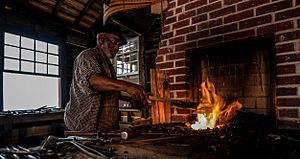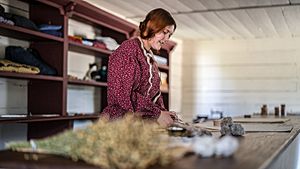Westville (Georgia) facts for kids
Historic Westville was a special kind of museum called an open-air museum. It showed what a town in the 1800s looked like in the U.S. state of Georgia. The museum first opened in 1970 in a town called Lumpkin, Georgia. Later, in 2019, all the old buildings were moved to Columbus, Georgia. The museum closed in 2023. However, there are plans for it to open again in the fall of 2025.
Contents
The Dream of John Word West
The idea for Historic Westville came from a man named Lt. Col. John Word West. He was a history professor at North Georgia College. John West was born in 1876. At that time, Georgia was changing a lot after the American Civil War (1861–65). Big cities like Atlanta were growing, and farming was becoming less common.
As a child, West loved listening to his grandparents tell stories. They talked about the old ways of life that were slowly disappearing. He learned many old skills from them. Later, he wanted to save these stories and skills for everyone to see.
Saving Georgia's History
In 1928, John West started using his own money to save old "Georgiana." This included buildings, tools, furniture, and traditional work skills from Georgia's past. He was inspired by others who were also saving history. These included John D. Rockefeller, Jr., who started Colonial Williamsburg in 1927, and Henry Ford, who created Greenfield Village in 1928. West even talked to these men for advice.
The Fair of 1850
In 1928, John West opened his own museum called "The Fair of 1850." It was in Jonesboro, Georgia, near Atlanta. From 1932 to 1934, he moved some of the oldest buildings he had collected to this site. One special building was his grandparents' old log house. At the Fair, West and others showed visitors how people lived long ago. They demonstrated skills like woodworking, making cloth, cooking over a fire, and shoemaking. John West hoped the state of Georgia would take over his project, but this did not happen before he passed away in 1961.
Westville's First Home in Lumpkin
Five years after John West died, people in Stewart County decided to create a new way to attract visitors. They wanted to focus on "heritage tourism." Stewart County was changing from a farming area to something new. The county still had many old buildings and items from before the Civil War. Many people there also knew the old handicrafts that John West loved. It was almost like the Stewart County of 1850 still existed in 1966.
A New Beginning for West's Collection
Dr. Joseph Mahan, a friend of John West, helped save West's collection. Dr. Mahan worked at the Columbus Museum of Arts and Crafts. He made it his goal to keep West's dream alive. One evening, he shared his idea for a village where old houses could be moved and saved. He also wanted to show historic crafts and trades, and give jobs to local people.
With Dr. Mahan's help, the museum received 59 acres of land in Lumpkin. This led to the creation of Westville Historic Handicrafts in June 1966.
By 1969, the new museum bought John West's collection. It opened to the public in the spring of 1970. Six of the oldest buildings from the Jonesboro site were moved to Westville. Many of West's old items also came along. Other parts of the collection were given by many different people. In 2001, the museum changed its name to Historic Westville. The goal was to show more than just handicrafts. They wanted to show what daily life was like in the past.
In 2014, there was talk about moving the museum to Columbus, Georgia. Some people protested this idea. By July 2016, the Lumpkin location was closed.
Westville's Home in Columbus
Historic Westville opened again on June 22, 2019, in Columbus, Georgia. There are plans to bring more buildings from the Lumpkin site and show even more about history, as money becomes available.
Life in the 1800s
In October 2019, Historic Westville had live demonstrations and craftspeople every day. They wore clothes from the 1840s to 1860s. These "living historians" talked with visitors about what life was like in South Georgia during the 1800s. They focused on the interesting stories of the many different people who lived there.
Historic Westville has skilled craftspeople who show traditional trades. You can see leatherworking and bootmaking in the Singer Boot Shop. South Georgia quilting is shown in the Singer House. Traditional carpentry happens in the West Wood Shop. Blacksmithing is done in the Woodruff Blacksmith Shop. Westville also has a dressmaker who hand-stitches all the clothes worn by the interpreters. These craftspeople use old methods and tools from that time period.
Westville closed in February 2024. However, a new director, April Kirk, has been hired. The museum plans to open its doors again in the fall of 2025.
See also
 In Spanish: Westville (Georgia) para niños
In Spanish: Westville (Georgia) para niños





